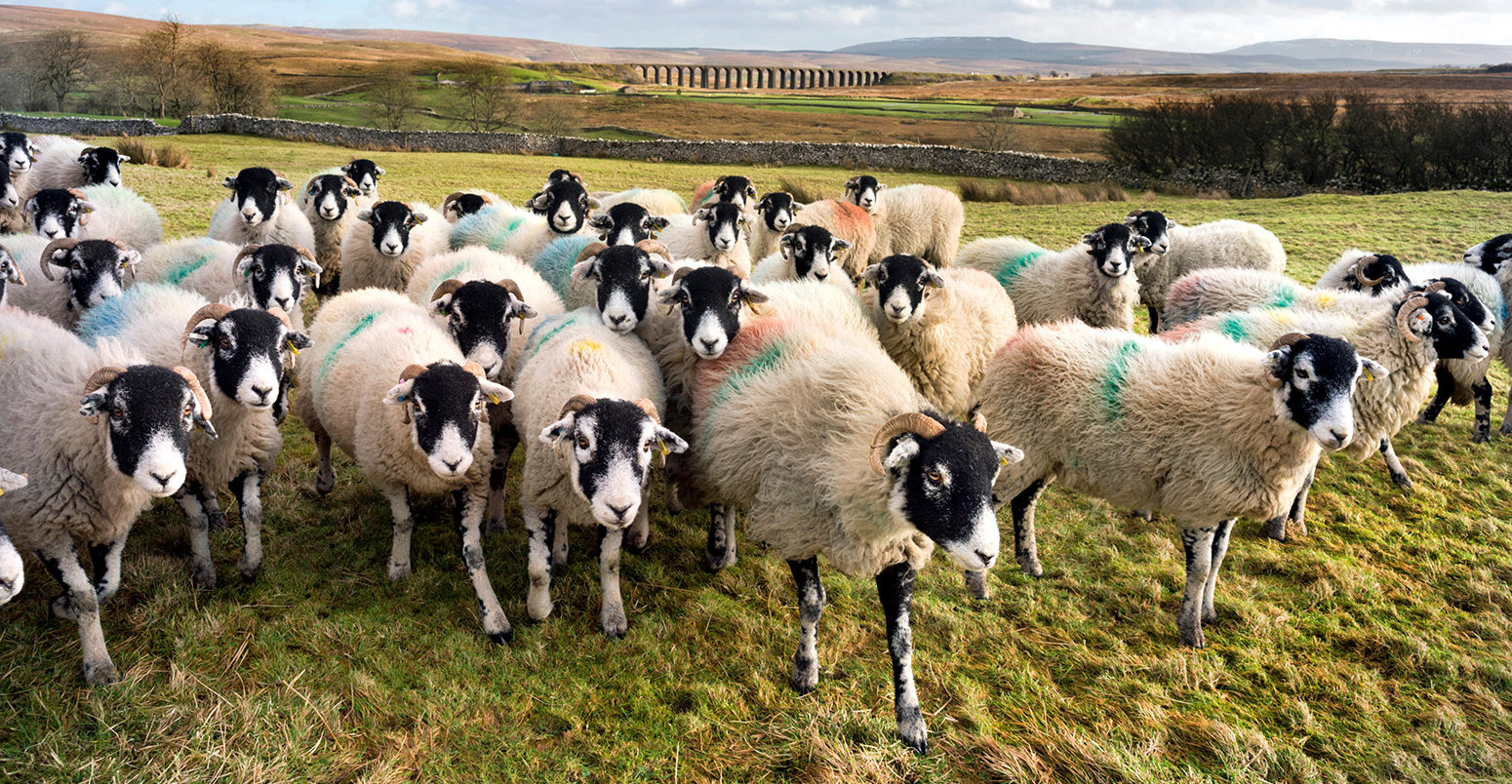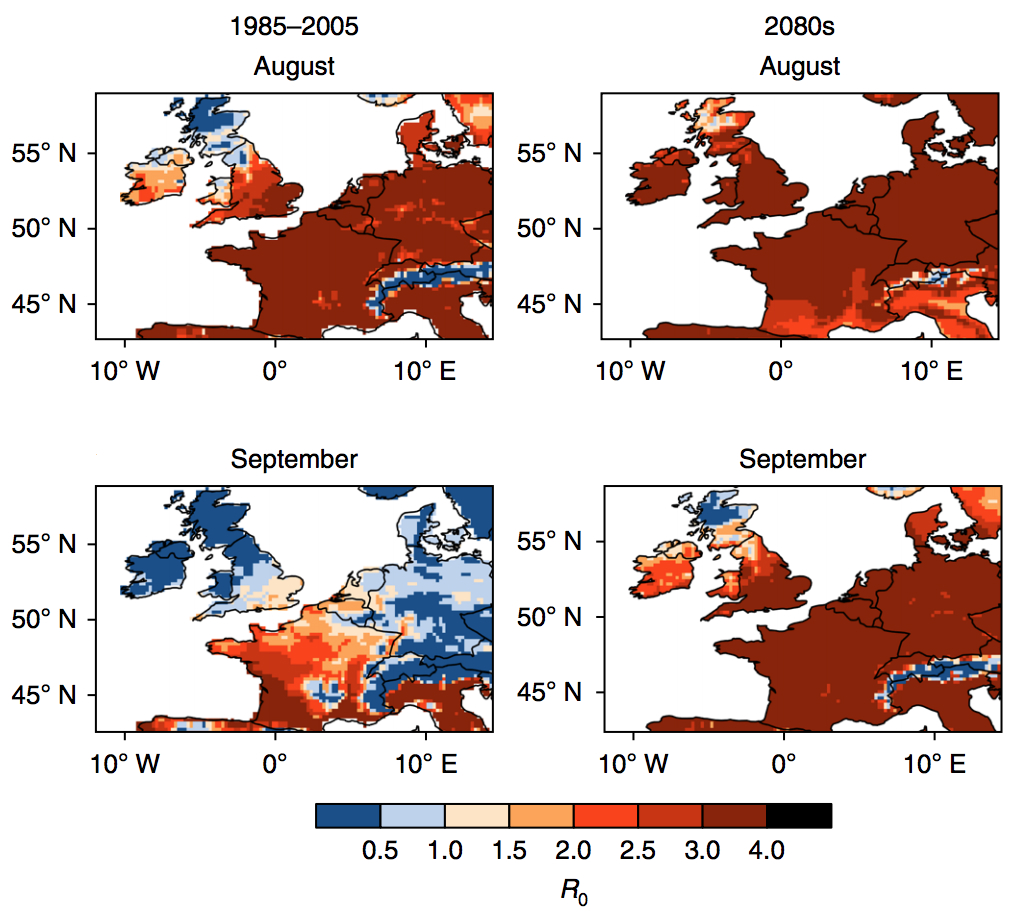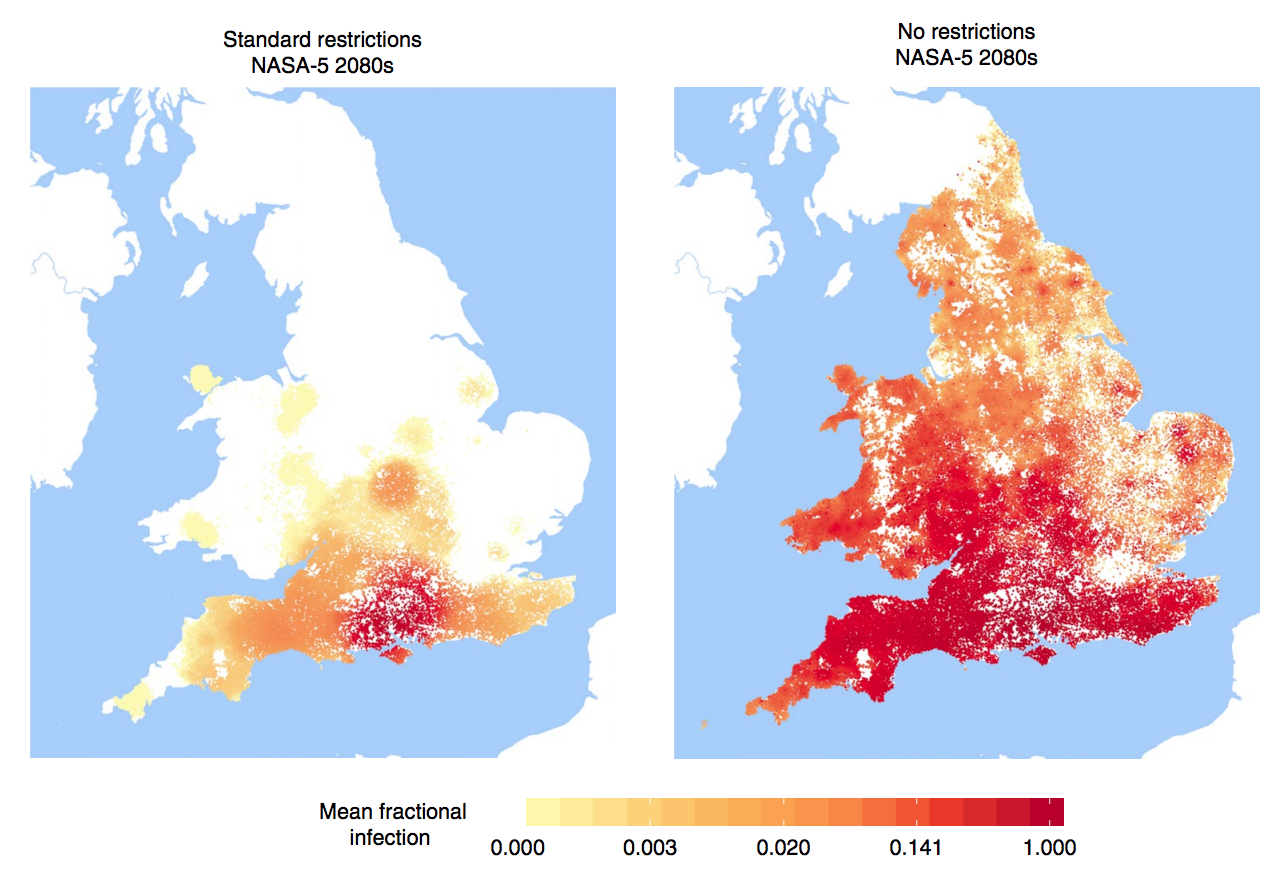
Guest post: Climate change brings threat of ‘bluetongue’ virus to UK farms
Multiple Authors
01.18.19Multiple Authors
18.01.2019 | 12:09pmDr Anne Jones is a former postdoctoral researcher at the University of Liverpool, now at IBM Research; Dr Cyril Caminade is a tenure track fellow at the University of Liverpool; Prof Andy Morse is professor of climate impacts at the University of Liverpool; Dr Joanne Turner is a postdoctoral researcher at the University of Liverpool; and Prof Matthew Baylis is Oxenhale chair of veterinary epidemiology at the University of Liverpool.
Bluetongue is a viral livestock disease that can cause fever, swelling and death in sheep, and can also infect cattle, deer and other ruminants.
Originating in Africa, the disease has spread to Europe over the past two decades, carried by infected biting midges blown across the Mediterranean Sea. With the help of climate change, bluetongue has become established in southern Europe and is now emerging in northern regions, too.
Our new study, published this week in Nature Climate Change, finds that this expansion is set to continue as temperatures rise, with potentially devastating outbreaks threatening farms in the UK.
Out of Africa
Bluetongue gets its name from the swollen, purpley-blue tongue it can cause in infected animals. While other symptoms differ between types of livestock, they can include reddening of the lining of the mouth and nose, difficulty swallowing and breathing, lameness and failed pregnancies.
The impacts tend to be worst in sheep, but cattle are the main carriers of the disease (although they usually do not show symptoms). If untreated, the disease can cause death, with potentially high mortality rates. An outbreak in the Netherlands in 2006, for example, saw an average of 5% of infected sheep die, but rates were over 70% in some flocks. The disease does not infect people, but it can cause severe economic losses to farmers through death of animals and lost trade.
Bluetongue virus occurs in several forms (called “serotypes”) and is spread by the bites of “Culicoides” midges. Its transmission is inextricably linked to the temperature of the surrounding environment. Midges are cold-blooded insects, meaning higher temperatures can accelerate their lifecycle, population size, range and the development of the bluetongue virus within adults. Outbreaks are most common towards the end of summer when infected midge population numbers peak.
Midges are cold-blooded insects, meaning higher temperatures can accelerate their lifecycle, population size, range and the development of the bluetongue virus within adults.
Outbreaks in southern Europe in the 1990s were linked to an expansion in the range of the African midge, Culicoides imicola. But, in August 2006, bluetongue virus (specifically serotype 8) appeared unexpectedly in northern Europe, hundreds of kilometres further north than ever before, transmitted this time by native midges.
The exceptionally warm European summer of 2006, which subsequent research confirmed was the most conducive for bluetongue on record, was the trigger for this three-year outbreak. It affected tens of thousands of farms at a huge financial cost and resulted in the deaths of millions of animals (both through the disease itself and the slaughter of infected animals). It was only brought to a halt by a newly developed vaccine.
In 2015, bluetongue appeared again in France and has continued to spread further each summer, reaching Switzerland and Germany, and has even been detected in cattle imported from France into the UK.
Predicting bluetongue risk
Two main ingredients are needed for a bluetongue outbreak to occur: favourable temperature conditions for the midge and the virus, and the spread of infection between farms.
While it is not possible to control the movements of midges, there are strict government controls on movements on animals from farms where the bluetongue virus has been detected. However, because the virus has an incubation time of between five and seven days – along with the low proportion of infected cattle which show any sign of the disease – infection can escape before it is noticed.
To understand where bluetongue outbreaks might occur, how quickly they might spread and how best we might control them, we use mathematical models which simulate transmission based on real movements of animals between farms and the effects of temperature on the virus and on midges.
In 2007, the first – and to date only – UK outbreak occurred. It was thought to have been introduced by bluetongue-infected midges carried on the wind from mainland Europe across the English Channel.
The UK outbreak was relatively small and our research has suggested that this was a lucky escape: a combination of geographic location of the virus introduction, the moderate temperatures experienced in 2007, and pre-existing animal movement restrictions in place to control foot-and-mouth disease helped limit the 2007 UK outbreak to 135 farms.
Were bluetongue to have been introduced to the UK in 2006, our simulations show the number of farms affected could have been a factor of 10 larger.
Future outlook
Our study also investigates how changing temperature conditions in northern Europe might affect bluetongue outbreaks.
We find that the area at risk for bluetongue transmission extends further north, with the annual transmission season lasting up to three months longer by the end of the 21st century.
![]()
The maps below shows the potential future expansion of areas suitable for the spread of bluetongue. It uses a “basic reproduction ratio for disease transmission” for the recent climate (left-hand maps) and the 2080s under the high emissions scenario, RCP8.5 (right) during August (top) and September (bottom). Reproduction ratio values greater than one indicate that if infection occurred, it could be sustained, allowing the disease to spread and potentially leading to an outbreak.
The oranges and red shading show ratios above one, while the blues show those below. In the recent climate, much of the southeast UK already has temperatures that are suitable for bluetongue transmission, but this drops off into the midlands and further north. By the end of the century, however, all but the highlands of Scotland could be warm enough.

Maps show the basic reproduction ratio for disease transmission, “R0”, for current (left-hand maps) and future (right) climates, during August (top) and September (bottom). A ratio of greater than one indicates suitability for sustained bluetongue transmission. Source: Jones et al. (2019)
For England and Wales, our simulations suggest that an outbreak we might expect once every 20 years in the current climate could become typical for any year by the 2070s.
One concern in the UK is the possibility of bluetongue reaching high farm density areas in Wales, the south west and north west of England. Fortunately, our modelling suggests that animal movement restrictions can play a role in limiting the spread if an outbreak starts.
The maps below show the impact that animal restrictions could have if an outbreak began in southern England under a future climate. They show “mean fractional infection”, which is the proportion of model simulations for which a given farm is infected – therefore, a score of one indicates that a farm is infected in all simulations. The results are for an outbreak in the 2080s with (left-hand map) and without (right) restrictions to animal movements.
The right-hand map shows a much bleaker picture and illustrates the full potential impact of climate change. In this scenario, projected temperatures at the end of the 21st century result in widespread outbreaks, where more than 40% of all farms in England and Wales are infected in a one in 10-year outbreak under the RCP8.5 scenario. This would mean bluetongue infecting around 50,000 farms, which would otherwise be limited to around 2,000 with the restrictions in place.

Maps show “mean fractional infection” in England and Wales for the 2080s under RCP8.5, based on an original outbreak originating in Hampshire, England and assuming standard animal movement restrictions (left-hand map) and no restrictions at all (right). On a sliding scale from: zero = farm not infected in any simulation (shaded white), up to: one = farm infected under all simulations (red). Source: Jones et al. (2019)
Although our simulation model was developed for bluetongue, the transmission processes are similar for many insect-borne diseases. Climate change is expected to result in a large expansion of the areas potentially suitable for transmission of these diseases.
Therefore we expect that early, accurate disease detection, along with efficient strategies for disease control, will become increasingly vital in future, warmer climates.
Jones, A. E. et al. (2019) Bluetongue risk under future climates, Nature Climate Change, doi:10.1038/s41558-018-0376-6
-
Guest post: Climate change brings threat of ‘bluetongue’ virus to UK farms

